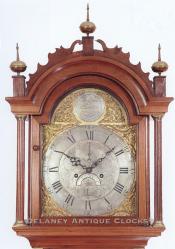Richardson Miner of Stratford, Connecticut. A cherry case tall clock by a rare Connecticut maker. 218002.
A fine cherry case tall clock with composite brass dial signed, Richardson Miner / Stratford, (CT).
This cherry case exhibits very narrow proportions. It is elevated off the floor on a formed applied bracket feet and single-step molding. Please note the wonderful "C" scroll return detail. The waist is long and narrow and centers a sizeable rectangular-shaped waist door. This door is trimmed with a molded edge. The door provides access to the pendulum and weights located in the case's interior. The hood rests on the upper cove molding. Fully turned and fluted hood columns are mounted in brass capitals. These flank the arched hood door and visually support the arched molding. The top of the bonnet is fitted with a whale's tail fret and three capped chimneys or plinths. The plinths each support a brass ball and spike finial. Tombstone-shaped side lights or windows are located on the sides of the hood. These provide visual access to the interior of the case.
This style of this dial predates the painted dial form. It is composed of a brass sheet and is decorated with six applied matching cast brass Rococo style spandrels, a centrally fitted engraved name boss is located in the lunette, an engraved time or chapter ring, an engraved seconds register, an aperture for the calendar day and a decoratively engraved center. The name boss is signed with the clockmaker's name and working location. It reads, "Rich son / Miner / STRATFORD." The time ring is formatted with Arabic-style five-minute markers, a closed-minute ring, and Roman-style hours. The engraved decorations in the center are an exhibition of the engraver's skill. They are wonderfully executed and worth pointing out. (Note: The fact that this dial has an engraved center may suggest that it is the youngest of the four clocks known.)
The movement is constructed in brass and is weight-driven. It is designed to run eight days on a full wind and strike each hour on a cast iron bell. The striking system features a rack and snail setup. The cast iron bell is mounted above the movement. The movement is of good quality.
This clock has the following approximate dimensions. The case stands 7 feet 6 inches tall (90 inches) to the top of the center finial. Measured at the upper hood molding, it is 20 inches wide and 10 inches deep.
The fact that this dial has an engraved center may suggest that it is the youngest of the four clocks known. This clock may have been made circa 1785.
It is inventory number 218002.
Richardson Miner was born in 1736 and died in 1797 at the age of 61. He was the son of Reverend Richardson and Elizabeth Munson Miner. It is not currently known who trained him as a clockmaker. We can assume that he was born with a great deal of mechanical ability because he is listed as a clockmaker, goldsmith, and as a silversmith. He also served in the Second Connecticut Regiment under Colonel Nathan Whiting during the 1760 campaign of the French and Indian Wars. This regiment was stationed at Fort No. 4. During the 1760s, this Fort was the furthermost British settlement. No. 4 was situated along the eastern bank of the Connecticut River, which is now located in the town of Charlestown, New Hampshire. This outpost was continually under pressure from Indian attacks. Miner served this regiment as an armorer. It was his job to keep the muskets and the weapons of the regiment in good repair. It is thought that he moved from Stratford to New Haven sometime around 1760 and was married there in 1764. He may have moved back to Stratford at some point. Tall clocks are known signed in both locations.
Five tall clock examples are currently known to us. Four of these are signed as being made in Stratford. One is currently for sale here in our showroom. A second signed Stratford example is pictured in Dean Fales's book, The Furniture of Historic Deerfield, on page 259. A third signed Stratford example is illustrated in figures 12 and 36 in Penrose R. Hoopes's book, Connecticut Clockmakers of the Eighth Century, reprint, New York, 1974. The fifth know clock is signed by Minor but differs in that the location is signed as being New Haven. This clock is also currently in our inventory. All five clocks are signed in the same hand. This suggests that he may have done his own dial engraving.














